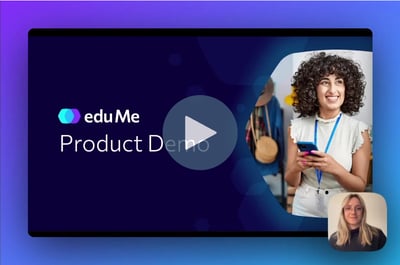Contrary to popular belief, on-demand learning is not a recent phenomenon. On-the-job training, a type of informal, on-demand learning, is a time honored mainstay of corporate training.
However, in a remote, post-pandemic world, HR Departments are finding traditional in-person Learning & Development (L&D) methods - including on-the-job and instructor-led training - to no longer be the most viable options. Instead they look to a third, fully digital option - on-demand training.
On-demand training delivered digitally defines the future of corporate learning. But if it isn’t identical to on-the-job training, how exactly does it differ and what makes it so advantageous?
→ Download Now: Revitalize your Learning & Development Strategy for 2021 [Free Workbook]
What is on-demand training?
Besides being costly and time consuming, it’s widely known that in-person instructor-led training (ILT) is not particularly effective. Why? It provides a passive learning experience, and passive learning suffers “the lowest knowledge retention rate of any method of learning”.
The definition of on-demand learning
On-demand training, on the other hand, is a learning strategy that enables employees to learn in a way that's optimized for them - at a time, pace and place of their choosing.
With on-demand training when an employee needs information, and their informational needs are met at that moment. Employees are able to implement newly gained knowledge immediately. This heightens its impact - learners retain 90% of what they learn when they use it immediately.
Unlike conventional L&D training methods that give the instructor near-total authority to decide the pace, time and location of the class, on-demand training gives that power to the trainee - employees are able to access relevant training materials at their point of need.
On-demand training has also been titled 'learning in the flow of work’, a phrase (and concept) coined by Josh Bersin. Instead of designing stand-alone employee training content, the learning in the flow of work paradigm re-imagines employee training. Employees can access relevant information about the specific task they are performing without embarking on a multi-lesson course or sitting through a 40-minute video.
In summary, on-demand training leverages advancements in technology to deliver learning that meets modern learners’ novel needs. That is - it’s bite-sized, relevant and timely, to create a flexibility and convenience that best support learners’ in acquiring new skills. It’s no longer a preference, but an expectation and prerequisite for success - 57% of employees expect training to be delivered on-demand.
What is microlearning?
Microlearning is a learning framework where material is delivered in concise manageable units that learners consume in short, 2-5 minute bursts.
With microlearning, learners don't have to put aside entire hours, days or weeks to get the lessons they need all at once. This appeals to most employees who have on average only 4 minutes a day to dedicate to learning and learners are 58% more likely to be engaged when information is delivered in this way.
As a result of microlearning and the ever-increasing access to technology in our society, workplace training now favors the on-demand model - micro, personalized and accessible via a smartphone. Platforms like eduMe deliver learning content in easy-to-digest doses designed to increase engagement and promote higher knowledge retention.
On-demand training and mobile technology
It is safe to say that on-demand training would not exist as it does now without the proliferation of mobile technology globally. As of 2020, 44% of the world’s population had a smartphone. In 2019, global internet access points were split 50-50 between mobile devices and computers (laptops included).
This rise in smartphones and other mobile 'smart' devices like tablets made it easy for trainers and employers to transition from conventional Learning Management Systems (LMS), which offer their learning content on desktop, to the new mobile-first platforms. These platforms provide their content in a more customized and flexible manner that learners can consume anywhere while on-the-go via their mobile devices.

Why is on-demand training essential?
It is easy to see that on-demand training is more convenient for learners. Learners can study anywhere, on any device at a time that suits them. However, convenience is not the only reason why on-demand training is essential and why your company should partner with platforms that offer this service.
Here are just 4 other reasons why on-demand training is important:
1. More millennials in the workplace
Millennials comprise 50% of the workforce, and they have high expectations of their employers when it comes to their workplace training. This generation were weaned on technology, and expect nothing less than a training experience that mirrors their experience with consumer grade technology, i.e. apps they make use of in their leisure time.
Gone are the days of the one size fits all training program designed around the model learner. Millennials require personalized, easy-to-access, point of need training that empowers them to perform their jobs to the best of their ability with minimum interference to their daily tasks.
2. The rise of remote work
While there has been a growing trend of working remotely worldwide, 2020 dramatically increased those numbers due to the Covid-19 pandemic. According to a 2020 report by Gallup, 43% of the US workforce was already working remotely, either fully or partially, before the pandemic. That number has now almost doubled.
Furthermore, in a Future of Work survey of executives and managers, 78% of the respondents listed “flexible schedules and telecommuting” as their most effective non-monetary ways to increase employee retention.
This shift away from the conventional 'workplace' to our living rooms, kitchens means that job training can no longer effectively happen on-site. And for the 2.7 billion deskless workers world-wide, it work never existed on-site.
With workforces dispersed and attention at a premium, learner’s only have capacity for the most important or relevant information. When training is delivered at peoples’ point of need, it must be brief (and tailored) in order to cut through the noise of emails, SMS, notifications and workplace communication tools.
4. On-demand learning is cheaper and cost-effective
One pitfall of conventional L&D methods is that they are costly. In 2019 instructor-led, classroom-style training accounted for 40% of the total training hours. As a result, training expenditure on travel, facilities and equipment in the US alone amounted to $23.8 billion.
In the same year, training expenditure on payroll was $51.7 billion, a 10% increase from 2018. Mobile-based on-demand training took up less than 5% of the total training hours, even though it would have been about 50% cheaper to teach the same material using the on-demand approach.
Why’s there a difference? With instructor-led training, an instructor takes a stab in the dark at what a whole group of people may or may not know. They aim for breadth - to cover a wider range of topics - in order to appeal to larger audience. With on-demand training its about the individual’s experience and journey. By nature, it is tailored to them, meaning time isn’t wasted bombarding the wrong people with the wrong snippets of information.
Because the programs were held at the instructor's pace and not the learners, they weren't as beneficial for learners, so the businesses spent a lot of money to see minimal results. As on-demand learning is self-paced, employers get value back for their money in real-time as employees know what they need to, when they do and are able to execute their tasks in an productivity optimizing way.
Are you ready to step into the future of work and join companies at the apex of their industries, like Uber, Vodafone and Deloitte, with an easy-to-use, remote training tool that delivers vital knowledge to whoever needs it, on-demand?
Try eduMe today to cater to your learners’ needs and maximize employees’ productivity, boosting your bottom line in the process👇







